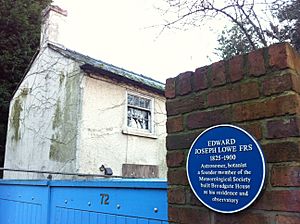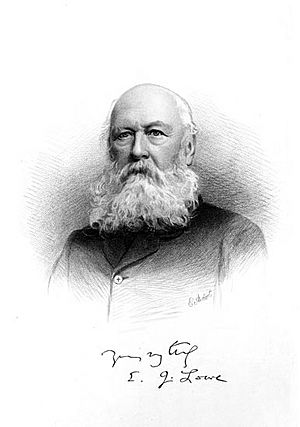Edward Joseph Lowe facts for kids
Edward Joseph Lowe (born November 11, 1825 – died March 10, 1900) was a famous English scientist. He was a botanist (someone who studies plants), a meteorologist (someone who studies weather), and an astronomer (someone who studies stars and space). He wrote many papers about different topics like bright meteors, sunspots, and even how the weather changed during a solar eclipse in Spain in 1860. He also studied shells, ferns, and grasses.
People sometimes called him "The Big Snowflake" because of his beard!
Contents
A Young Scientist's Journey

Edward Joseph Lowe was born into a wealthy family in Nottinghamshire, England. His father, Alfred Joseph Lowe, was also very interested in science, especially weather and space. Edward started making his own scientific observations when he was just 15 years old!
Studying Plants and Weather
Edward became very interested in ferns. His most famous work was an eight-volume book called Ferns: British and Exotic, published in 1856. The beautiful pictures in the book were drawn by A. F. Lydon.
He also worked with Professor Baden Powell (a mathematician) to observe bright meteors. Edward even invented a special test using dry powder to measure ozone in the air. Ozone is an important gas in our atmosphere.
Edward was a founding member of the Royal Meteorological Society, which studies weather. He was also a member of many other important scientific groups, like the Royal Society, the Geological Society, the Linnean Society, and the Royal Astronomical Society. These groups recognize top scientists for their work.
Building Observatories
After a big exhibition in London in 1851, there were plans to build a public observatory in Nottingham. An astronomer named Henry Lawson offered his collection of telescopes for it. However, the project didn't get enough money from the government.
So, Lawson convinced Edward Lowe to take the instruments instead. Edward built an observatory at his home, Broadgate House, in Beeston, Nottinghamshire, in 1849. This observatory opened in 1855 and had a special rotating roof.
The Beeston Observatory was mainly used to study weather. It had regular weather tools, but also a unique "Earthquake Pendulum." This pendulum went up 33 feet to the top of the building. If an earthquake shook the building, the pendulum would make a mark on a piece of chalk, showing the movement. Edward also put special devices called Electrometers on the roof to measure electricity in the air from lightning.
Edward's father, Alfred, also built another observatory nearby in Beeston. This one was used until 1965.
Important Expeditions and Societies
In 1860, the government sent an expedition to Spain to observe a solar eclipse. Edward Lowe was put in charge of the weather observations for this trip.
He was also a local secretary for the British Science Association meeting in Nottingham in 1866. In 1868, he became the president of the Nottingham Literary and Philosophical Society.
When botanists refer to Edward Lowe's work on plants, they use the short name E.J.Lowe.
Edward married Anne Allcock in 1849. They had two sons:
- Alfred Edward Lawson Lowe (1849-1888)
- Hugh Lee Peyton Lowe (1857-1933)
In 1882, Edward moved from Beeston to Shirenewton Hall in Monmouthshire, where he passed away on March 10, 1900.
Gallery




